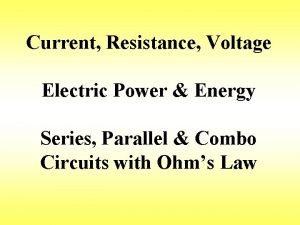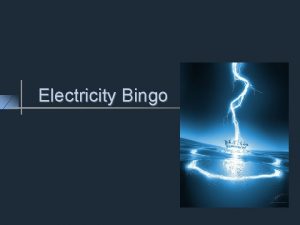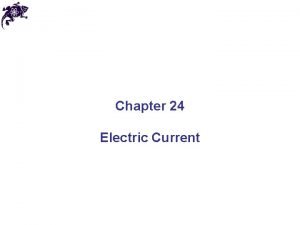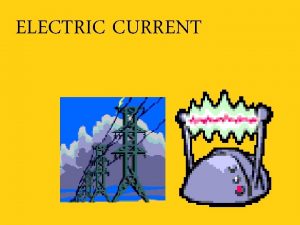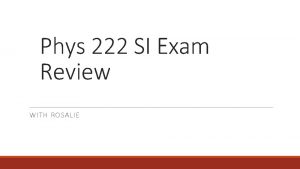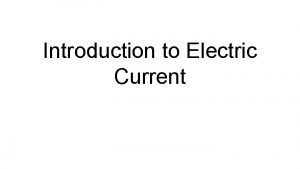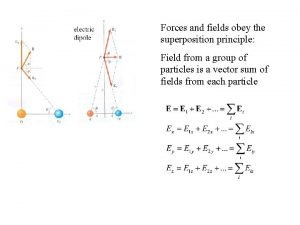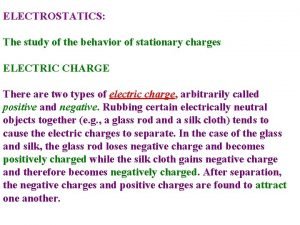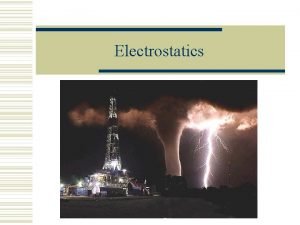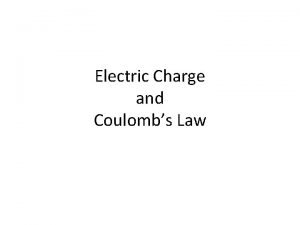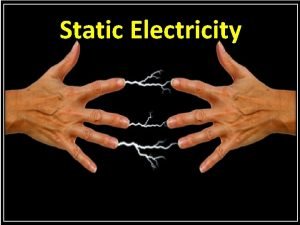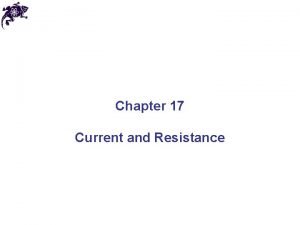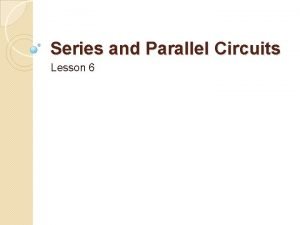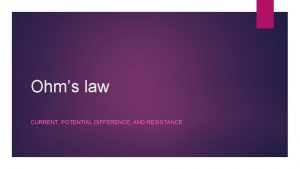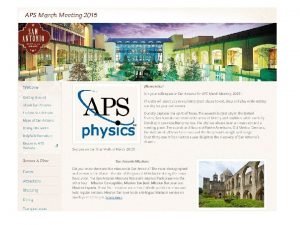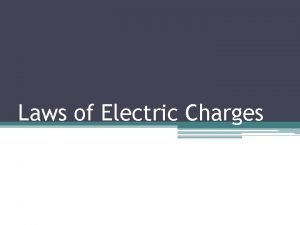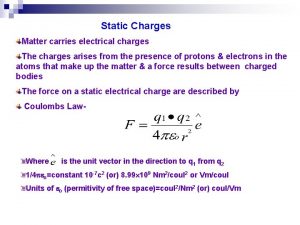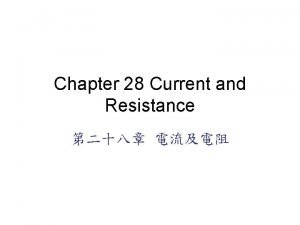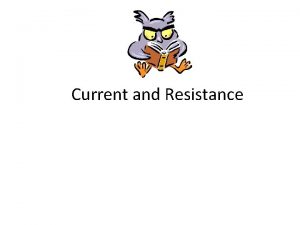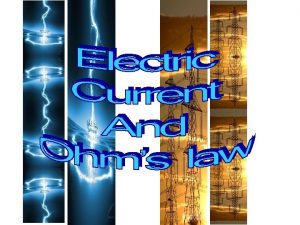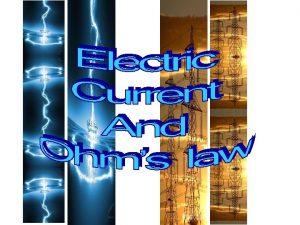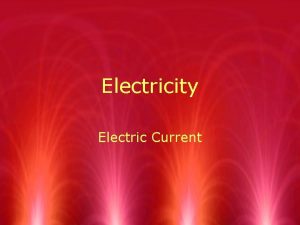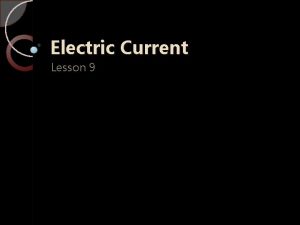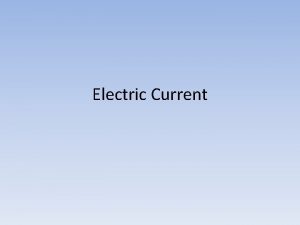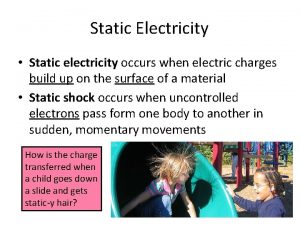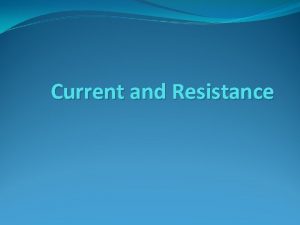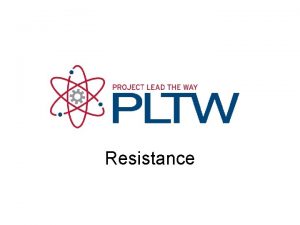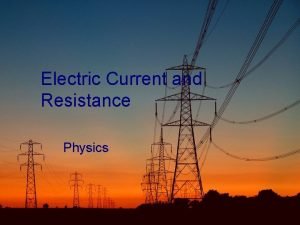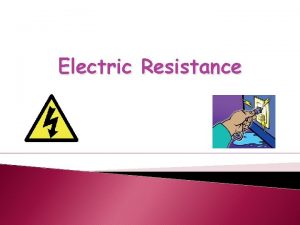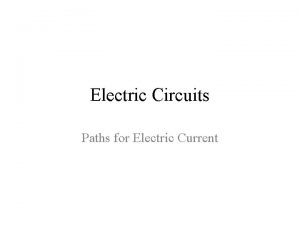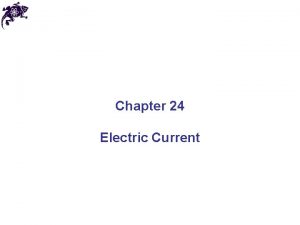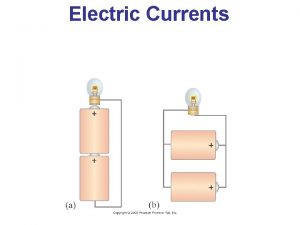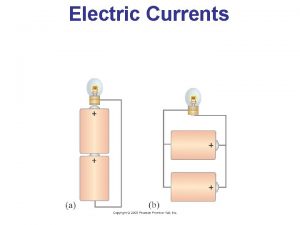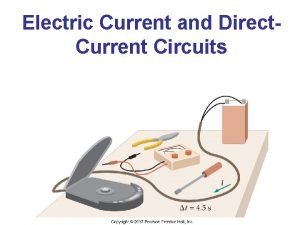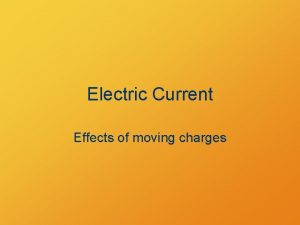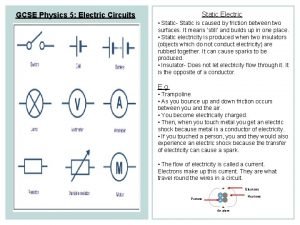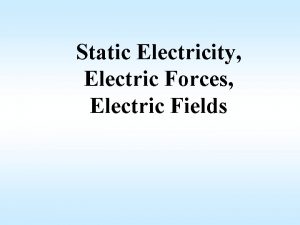Electric Current and Resistance Moving Charges n Static


























- Slides: 26

Electric Current and Resistance

Moving Charges n Static charges will move if potential difference and conducting path exists between two points n Electric field due to potential difference creates force on charges

Moving Charges n In solids, moving charges are electrons n In liquids and gases, both positive and negative ions can move n Electrolyte: substance whose aqueous solution conducts electric current n Positive charge moving one direction is equivalent to negative charge moving in opposite direction

Electric Current n Rate of flow of electric charge through a cross section of a conductor n Unit is ampere (A or amp); 1 A = 1 C/s n Ampere is a fundamental unit of SI system n Electrons flow from negative to positive n Conventional current is flow of positive charges from positive to negative (thank you Ben Franklin)

Electron Drift Speed n Electrons are pushed by electric field established in conductor n Electrons possess thermal velocity ~ 106 m/s, causes random collisions with atoms n Speed due to electric field much less ~ 10 -4 m/s, called drift speed n Collisions create resistance to flow of charge

Resistance n Due to collisions of conduction electrons with atoms n Unit is ohm (W); 1 ohm = 1 V/1 A n Circuit elements designed to provide measured amounts of resistance called resistors

Resistance Laws n Resistance of uniform conductor directly proportional to its length, inversely proportional to its cross sectional area n Resistance increases when temperature increases for most metals n Resistance depends on nature of the material: the resistivity (rho) has units of ohm cm; R = r l/A

Range of Resistivities n Low resistivity materials called conductors; most metals n High resistivity materials called insulators; nonmetals n In between are semiconductors: Si, Ge, B, Se; can act as conductors or insulators under certain circumstances

Resistance and Temperature n Most conductors have a wide temperature range where resistance is constant—called ohmic because they obey Ohm’s Law (I=V/R) n Resistance increases at high temperature— light bulbs are non-ohmic n Resistance of many semiconductors varies directly with temp. —digital thermometers

Superconductivity n Discovered by Onnes (1908) while investigating low temp conductivity n Resistance drops suddenly to zero at critical temperature n Critical temp for most materials is a few kelvins, but newer composite materials found with superconductivity at higher temperatures

Superconductivity n Practical uses include MRI machines, levitating, high speed trains, research

Electric Shock n Current causes injury, not voltage n Currents can be high if skin conductivity is high -- wet or salty n Must be a potential difference for current to flow -- connection to high voltage not dangerous unless path to ground exists n Grounded (3 wire) and polarized plugs help prevent shocks

Direct and Alternating Current n DC: direct current, flow of charge in one direction only – batteries n AC: alternating current, electrons vibrate back and forth; don’t actually flow through circuit n In USA, current alternates between +120 V to 120 V at 60 Hz n AC can be transmitted for long distances with little loss due to heat

Converting AC to DC n Often need DC for electronic devices (stereos, computers, TV, etc. ) n Diode acts as one way valve turning AC into pulsed DC n 2 or more diodes together can provide smoother DC n Capacitors also used to smooth out DC signal

EMF n Charged capacitor can discharge and move charges but only until potential on plates is equal n For continuous current, need sustained potential difference and closed conducting path or circuit n Work must be done on charges to maintain potential difference; called emf; Unit: volt; symbol: script E

Quick Quiz n If 1. 5 C of charge passes a point in 5 s, what is the current? n What is the symbol for current in an equation? n What is the symbol for the resistance unit? n What electronic component can act as a oneway valve to convert AC to DC?

Quick Quiz n Which type of current is produced by a battery? n What 4 factors determine the resistance of a wire? n Which wire will have the least resistance?

Ohm’s Law n Circuit current is determined by emf (voltage) of source and resistance in circuit. n where V is source voltage, I is source current and RT is total resistance in circuit n Internal resistance of battery must be included in total resistance n V = IR gives voltage drop across any resistance element in circuit

Energy of Electric Current n Emf source does work on charges n Charges then do work on circuit components: resistors, bulbs, motors, etc. n One coulomb of charge moved through potential difference of one volt equals one joule of work done, energy increase also 1 J

Energy of Electric Current n W = q. V = VIt (since q = It) n For one electron moved through 1 volt, unit of work/energy is electron volt (e. V) n 1 e. V = 1. 60 x 10 -19 J

Energy and Resistance n Work done on resistance by current appears as heat; can be desirable (oven, iron, heater) or not (motor, light, computer) n Since resistance always present in normal circuits, some energy lost due to heat n Joule’s Law: Q = I 2 Rt n Use to calculate heat produced by resistance and current over a time period

Power in Electric Circuits n Since power is work or energy transferred/time, P = VI n For a resistive element, P = I 2 R power dissipated in a resistance n If current is not known, P = V 2/R n For total power in circuit, use V of battery or other source and RT (total resistance) of circuit for R

Power Companies n Energy sold in kilowatt-hours, a unit of energy (power x time) n 1 k. W-hr means device used 1000 watts of power for one hour n To minimize power loss in transmission lines, high voltages and fairly low currents used

345 - 750 k. V 345, 000 V 138 k. V 24 k. V 25, 000 V 5000 V 240 V 12 k. V

Quick Quiz n If the resistance connected to a battery is reduced, what will happen to the current? n If a 6 V battery produces 2 A of current, what is the resistance? n If 10 A of current passes through a resistance of 6 W, what is the rate that electrical energy is converted to heat?

Quick Quiz n If a motor draws 10 A of current from a 12 V battery, what is the resulting power? n Name three units used to express energy. n When current passes through resistance, what is produced?
 Electric charges and electric forces lesson outline
Electric charges and electric forces lesson outline Total resistance in a series circuit
Total resistance in a series circuit Like charges blank and opposite charges blank
Like charges blank and opposite charges blank Constant pressure filtration
Constant pressure filtration Force of air resistance
Force of air resistance Current is the rate at which charges move through a(n)
Current is the rate at which charges move through a(n) Electric current is the movement of
Electric current is the movement of The figure shows three electric charges labeled
The figure shows three electric charges labeled Continuous flow of electric charges
Continuous flow of electric charges Superposition principle
Superposition principle What is the study of stationary electric charges
What is the study of stationary electric charges Electron volt
Electron volt Electric charges of the same sign
Electric charges of the same sign Static electricity examples
Static electricity examples Coulomb's equation
Coulomb's equation Electricity flow
Electricity flow 17-1 current and resistance answers
17-1 current and resistance answers Lesson 6 current voltage and resistance in a circuit
Lesson 6 current voltage and resistance in a circuit Current potential difference and resistance
Current potential difference and resistance Young and freedman
Young and freedman A balanced delta connected load having an impedance 20-j15
A balanced delta connected load having an impedance 20-j15 Phase to phase voltage
Phase to phase voltage Energy band diagram of pnp transistor
Energy band diagram of pnp transistor Ac theory 3 lesson 4
Ac theory 3 lesson 4 Drift vs diffusion current
Drift vs diffusion current Ceramic composition resistors
Ceramic composition resistors In a delta connected source feeding a y connected load
In a delta connected source feeding a y connected load

